Menu
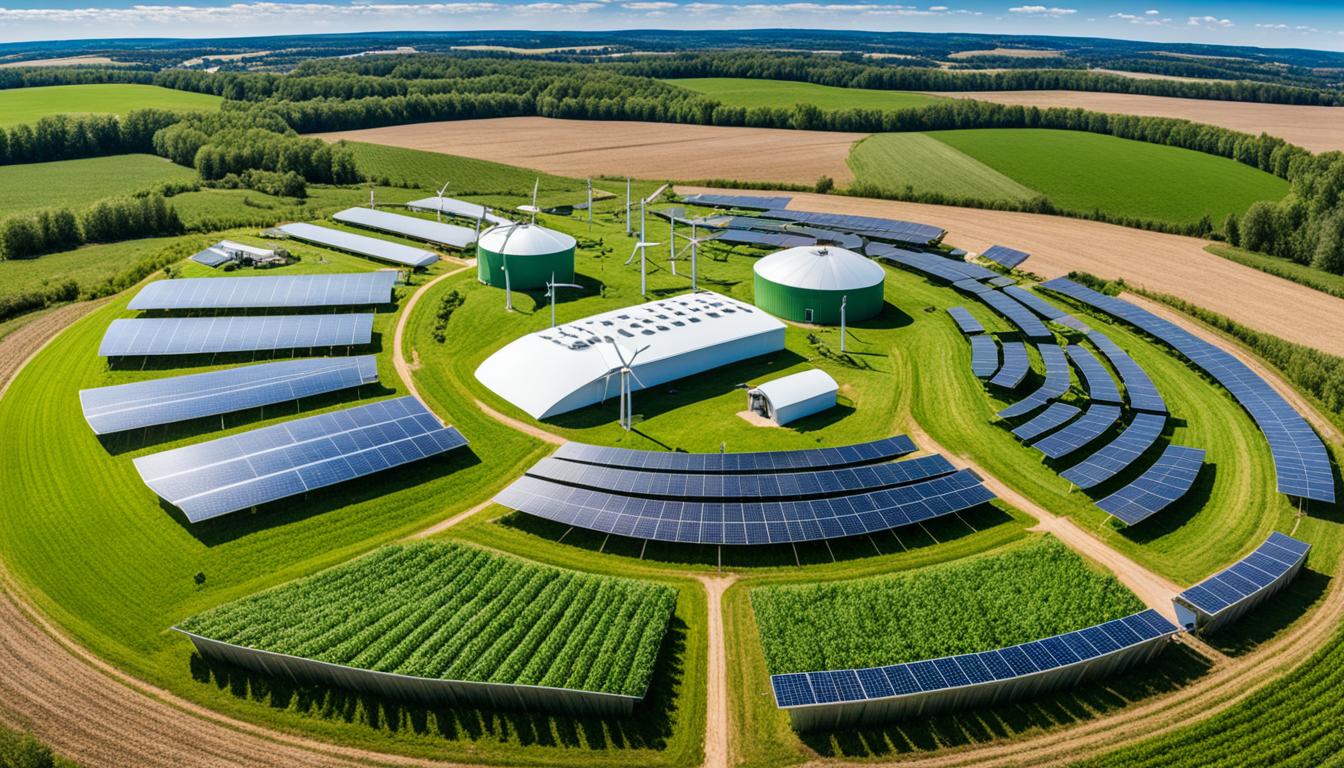
Did you know meat and dairy lead to the use of 83% of farmland but contribute 60% of farming’s greenhouse gases? The need to reduce farming’s carbon footprint is urgent. Agriculture causes over 31% of Earth’s human-made greenhouse gas emissions. Since our industrial start, the planet’s temperature has increased by one degree Celsius. This growth is mainly because of human actions. Agriculture plays a significant part in this.
It’s crucial to turn to farming that isn’t harmful for our climate. Climate-friendly farming can help the Earth and feed its growing population. Making farms sustainable is key. Such moves help in reducing the greenhouse gas effect. They also align with the UN’s target to reach net-zero on emissions by 2050.
The UK aims to reach net-zero greenhouse gas emissions by 2050, in line with the Climate Change Act 2008’s 2019 amendment. The Paris Agreement urges efforts to keep global warming under 2°C, with a preferred limit of 1.5°C. Given its significant role in emitting greenhouse gases, the agricultural sector has a big chance to lower its impact on the environment through practical strategies.
Carbon footprint refers to the gases produced by farming. Farming makes up a big part of these emissions, calling for carbon-neutral techniques. Using sustainable methods can greatly cut down these emissions.
Understanding data on emissions and how to tackle them is crucial for farmers. They should work out their carbon balance. The Agriculture and Horticulture Development Board (AHDB) stresses the importance of setting a farm’s baseline to make better choices. It’s key to check and update these calculations to track farming improvements.
Current methods for measuring emissions and carbon sequestration need to be more specific to UK farms. Exclusive UK farm data can better the way we model greenhouse gas effects. For example, planting cover crops can help improve soil health.
Using legumes to enrich soil with nitrogen and using drones to fertilise accurately can be game-changers. Also, spreading fertiliser multiple times during the growing season, not in one go, can reduce nitrous oxide.
New techniques are also in testing. For example, anaerobic digesters could lessen methane from manure. Trying different feed additives might also cut down methane from animals, although efficiency and safety need careful consideration.
Soil holds about three times more carbon than the atmosphere. This shows that farming practices can help move carbon from the air to the ground. Techniques like less tillage, returning crop residues, and growing perennials can increase soil carbon. This helps in achieving carbon-neutral farming and keeps land management sustainable.
| Strategy | Description | Impact |
|---|---|---|
| Cultivating cover crops | Increases soil organic matter | Debated effectiveness in reducing soil CO2 emissions |
| Using legumes as cover crops | Boosts soil nitrogen content | Reduces need for additional nitrogen |
| Drone-based fertiliser application | Targets specific areas accurately | Minimises nitrous oxide formation |
| Anaerobic digesters | Reduces methane from manure | Faces high costs and efficiency issues |
| Multiple smaller fertiliser applications | Spreads out over growing season | Reduces nitrous oxide emissions |
Employing these strategies is critical for cutting agriculture’s carbon footprint. They prepare the ground for exploring further methods in the upcoming sections.
Sustainable agriculture is essential for reducing the harmful impact of farming on our planet. A study in Science found that our earth is facing serious issues due to human activity (Steffen et al., 2015). This makes it crucial to adopt sustainable farming practices quickly.

In sustainable agriculture, the focus is on keeping the soil healthy. This is done through methods such as growing different crops each season, using fewer farm machines, and choosing natural over chemical methods. These ways help keep water in the soil and store carbon, which is good for the environment. Planting trees among crops and managing pests without harmful chemicals also help keep farms diverse.
Regenerative farming uses smart planting and animal grazing to trap carbon. This process reduces the impact food has on our climate and helps us fight against global warming. Besides these benefits, sustainable farming ensures there is enough food for everyone and keeps the balance in nature for our planet’s health over time.
| Key Practice | Benefit |
|---|---|
| Crop Rotation | Enhances soil health |
| Reduced Tillage | Increases water retention and carbon storage |
| Agroforestry | Promotes biodiversity |
| Cover Cropping | Sequesters carbon |
| Rotational Grazing | Reduces carbon footprint |
Big food companies and governments can help a lot in making farming sustainable. Companies can choose to buy from farms that use these good methods. And governments can choose to give money or breaks in taxes to those who farm in ways that are kind to the earth.
The move to sustainable agriculture is key for us to keep our planet and our farming healthy for the future. This is not just good for the earth but also for all the people who live on it.
Switching the crops we grow on farms, called crop rotation, is big in farming now. It helps the land keep healthy and boosts crop variety. By changing what we grow, farmers make the soil richer and cut down on crop problems like bugs and diseases.
Crops that change each season can lead to more food, season by season. For instance, research shows that mixing up crops can make corn harvests 28% better in most places. In dry seasons, mixed crops can increase corn harvests by 14 to 90%. Also, growing different things like corn one year and soybeans the next can make us harvest more corn (almost 40%) and more soybeans (over 50%) than if we just grew one type.
Crop rotation not only enhances yields but significantly reduces soil erosion, improves soil quality, and enhances biodiversity.
The best thing about changing our crops is how good it is for the soil. Each plant type needs different things from the earth. By switching them, we keep the soil’s nutrients in balance. This way, we don’t have to use as many man-made fertilisers that can harm the environment.
| Practice | Benefit |
|---|---|
| 3-Year Rotation (Corn-Soybean-Winter Wheat) | Increases corn grain yields by 38-42% |
| Crop Diversification | Increases food production; decreases net greenhouse gas emissions |
And there’s more good news. When we change our crops, we happen to let out less harmful gas from the soil. Nitrogen oxide decreases by 37 to 49% when we switch to corn after growing things like winter wheat or soybeans. This helps us farm in ways that are kinder to our world.
Effective nutrient management is key for sustainable farming. The 4Rs approach focuses on the right time, right rate, right source, and right place for fertilisers. It helps crops grow healthy while lessening harm to the environment. Let’s dive into each aspect to see how they boost efficiency and cut waste.
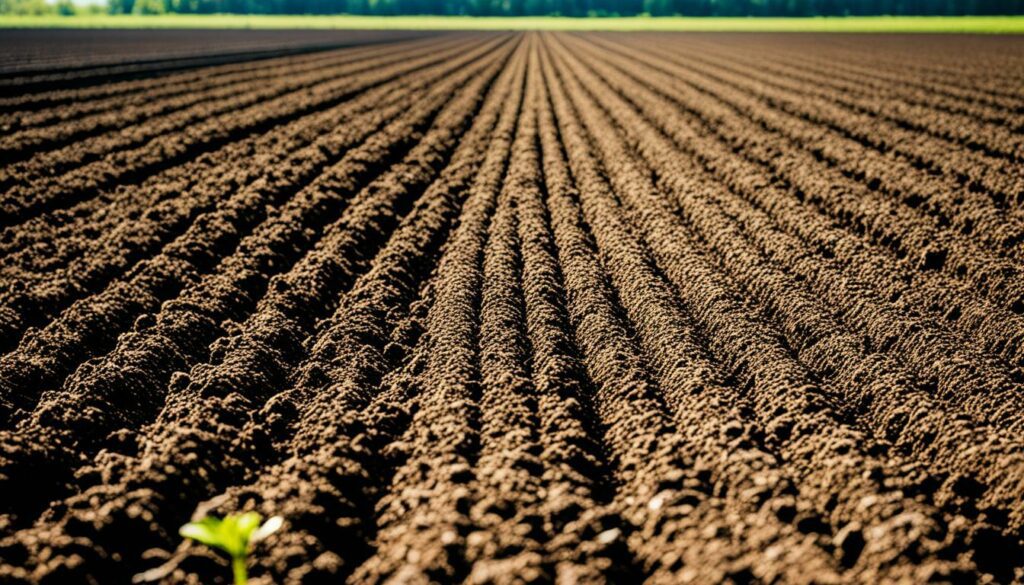
Choosing when to apply fertilisers is vital. Doing it when crops need them most makes the process efficient. The right rate ensures plants get what they need without extra going into water or air. In Canada, using the 4Rs has upped production on farms and made fertilisers go further.
Picking the best fertiliser type is crucial. It has to match your crop’s exact needs in a way they can use. This cuts down nitrous oxide emissions. Placing fertilisers where roots can easily get to them is also key. This way, plants take up more nutrients and there’s less waste.
Using the 4R Nutrient Stewardship lowers greenhouse gases. The Canadian 4R Research Network says it can cut nitrogen fertiliser emissions by 15 to 25%. These results meet the Nitrous Oxide Emission Reduction Protocol (NERP) standards for tracking and reducing emissions.
| Benefits | Impact |
|---|---|
| Improved Fertiliser Efficiency | Increased Production per Acre |
| Reduced Nitrous Oxide Emissions | Up to 50% Reduction |
| Environmental Sustainability | Preservation of One Billion Hectares |
Using the 4Rs for nutrient management is vital for cutting farming’s greenhouse gas share. It focuses on the best timing, rate, source, and place for fertilisers. This improves farm output and cares for the Earth by cutting down waste.
It’s vital to reduce the trend of leaving fields empty and bare. This can greatly help in managing land well and lessening the harm to the environment. By finding better ways and reducing bad effects, we aim for farming that’s friendly to our planet.
Fields left fallow can suffer from more soil erosion. This makes the land less fertile and reduces important organic material in the soil. It also means the use of more fuel, which makes up about 6% of emissions in farming. This way of farming also misses chances to help fight climate change by keeping carbon in the ground.
Cover cropping is a smart choice instead, improving the way we look after our land and cutting down on environmental harm. It makes the soil better by adding more organic carbon. That means less harmful gases in the air. This method brings other benefits too:
Mixing cover cropping with not tearing up the soil (no-till) can make the ground even better. It’s a key part of keeping the soil healthy and benefits the entire farming system.
Reduced tillage is key in striving for low-carbon agriculture. It cuts down on machine emissions and helps keep the soil healthy. Agriculture’s share of greenhouse gas emissions in the U.S. has gone up to 11%, from 1990. This trend can be countered by using methods like conservation tillage.
By 2016, U.S. farmers had saved over 812.4 million gallons of fuel through no-till farming. This could power about 3.2 million homes for a year. No-till farming boosts food security by making crops grow better, reducing greenhouse gases, and preventing soil erosion.
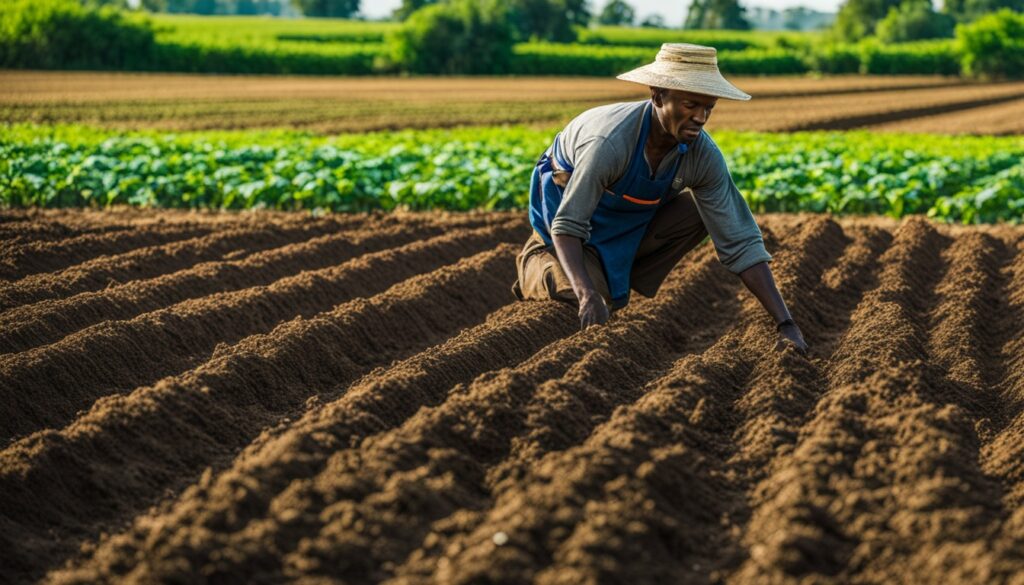
No-till farming is great at trapping carbon underground, a win against climate change. Various conservation tillage methods lower soil erosion, cut down on nutrient run-off, and decrease greenhouse gases.
A study from Stanford showed that conservation tillage raised corn yields by 3.3%. Shielding soil with more leftover plant bits can reduce soil loss. But tilling a wheat field in Minnesota? That released 3,800 pounds of CO2. Clearly, less tilling is better for the environment. It reduces soil damage and uses less fuel.
| Year | Practice | Benefit |
|---|---|---|
| 2020 | General Agriculture | 11% of greenhouse gas emissions in U.S. |
| 2016 | No-Till Farming | 812.4 million gallons of fuel saved |
| During Study | Conservation Tillage | 3.3% increase in corn yields |
| Yearly | No-Till Farming | Power for 3.2 million households |
Reduced tillage is a critical part of sustainable, low-carbon agriculture. It helps keep the soil healthy and plays a big role in cutting down the sector’s carbon output. The benefits of conservation tillage show why it’s so important for farming today.
Cover crops are plants grown in fields to help the environment. They are a helpful way to stop soil from washing away and polluting water. These crops make the soil better by adding more natural material to it. This helps the soil hold water and nutrients that plants need.
These plants also make the soil healthier for farming. They lower the need for expensive chemicals by grabbing nitrogen from the air. Cover crops help to keep water clean and trap carbon from the air, which is good for the climate.
Cover crops help the soil get more natural matter. This makes the soil more fertile and better able to keep water and nutrients. More organic matter in the soil means healthier soil, leading to bigger harvests. It also means farmers don’t have to use as many chemicals.
These plants protect the soil from being carried away by wind and water. They keep the soil covered, preventing the loss of important plant food and stopping the soil from getting too hard. In places where the land is easily damaged, cover crops help make farming more steady.
Farmers notice many good things when they use cover crops, like healthier soil and less harm to the water. They choose the right ones depending on the season to avoid difficulties.
Groups like the USDA’s Natural Resources Conservation Service help farmers use cover crops. They offer money and know-how. Thanks to these efforts, many more acres are now planted with cover crops, helping the planet and supporting better farming.
Properly managing manure is key to lower emissions in farms. The right application time and good storage can greatly reduce environmental harm. We will look into how to do this right.
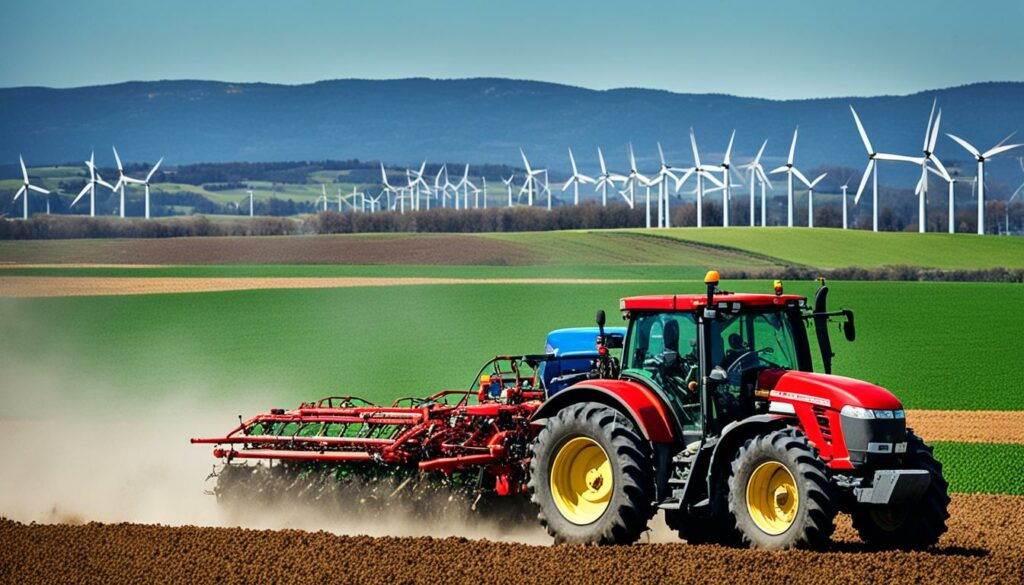
The correct time to apply manure is crucial. Applying it at the right time can lower greenhouse gases. For example, spreading it every day cuts down on methane. This is better than letting it sit in lagoons.
Moving to a pasture system can also cut down methane from stored manure. Although, it may slightly raise nitrous oxide emissions. It’s all about finding the best balance for the environment.
Storing manure well is important for lessening emissions. For instance, anaerobic digestion lessens methane because it uses it. Composting is also very helpful for certain types of animals’ manure if the moisture is right.
Composting reduces the size and weight of manure, which reduces costs. There are different composting styles for different manures, making it efficient. This also helps in managing nutrients.
| Management Practice | Impact on Methane Emissions | Additional Benefits |
|---|---|---|
| Daily Spread | Decreased | Optimised nutrient availability |
| Pasture-Based Management | Decreased | Carbon sequestration |
| Anaerobic Digestion | Reduced | Energy generation |
| Composting | Reduced | Volume and weight reduction |
By using these top methods in managing manure, we lower emissions and handle nutrients better. This supports sustainable farming. For more in-depth advice, the EPA guideline is a great resource.
Using renewable energy in farming helps our planet and our pockets. It makes farms more efficient, cuts costs, and supports eco-friendly practices. This is good for the earth and for business.
Farms can use sunshine and wind to power their operations. Solar panels reduce electricity bills a lot. Wind turbines turn windy days into money, as extra power can be sold. Biofuels like biodiesel and ethanol are green alternatives to petrol. They help us use less oil and cut pollution.
There are many financial perks for farmers who switch to renewable energy. The Inflation Reduction Act means the Rural Energy for America Program (REAP) can pay for half the costs. Farmers might get up to 75% funding using grants and loans together. Plus, the Investment Tax Credit (ITC) helps cut federal taxes by 30% on solar installations. Both the Department of Environmental Protection (DEP) and the United States Department of Agriculture (USDA) have offers for eco-friendly farming and biofuel use.
| Energy Source | Benefits | Incentives |
|---|---|---|
| Solar Power | Reduces electricity bills | Investment Tax Credit (ITC) |
| Wind Energy | Stores and sells excess electricity | REAP funding |
| Biofuels | Reduces dependence on fossil fuels | USDA Bioenergy Program |
Investing in green energy makes farms more efficient and eco-friendly. It cuts down harmful gases from farming, helping our planet. These steps lead to a more sustainable way of growing our food, fitting into worldwide efforts to fight climate change.
Using advanced fertilisers in farming is vital. It helps to make things more efficient while reducing harm to the environment. Farmers are finding new ways to feed crops. They want to do it smartly to boost farm productiveness and stay green. Controlled release fertilisers and fertigation methods are shining examples of this change.
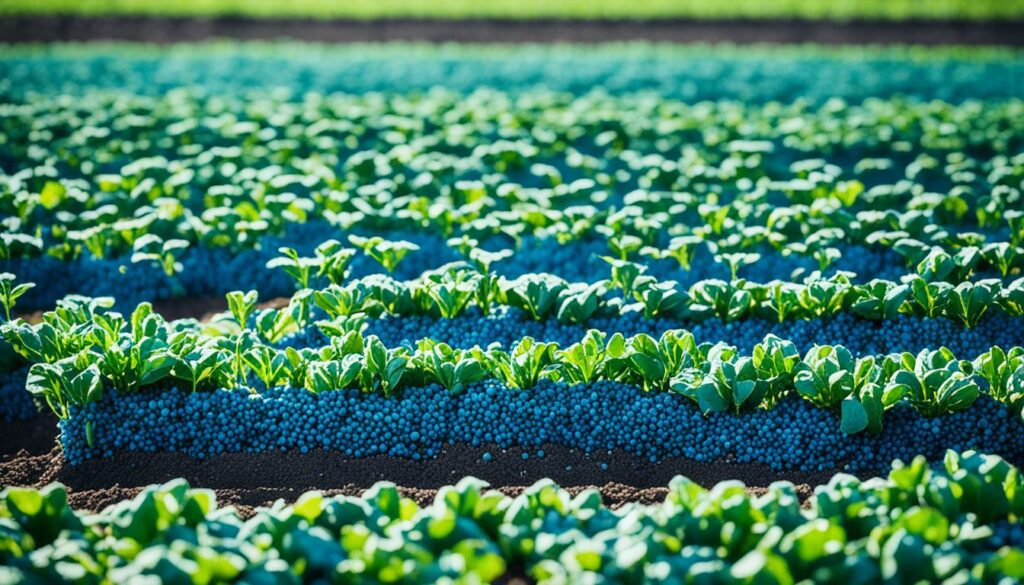
Controlled release fertilisers are a big step forward in how we manage plant food. They work differently from old-style fertilisers. Instead of giving out food quickly, these release it slowly. This helps crops use more of the nutrients, and it decreases water pollution. These fertilisers also help crops grow steadily and make the soil healthier, which is great news for the planet.
Fertigation combines watering crops with feeding them. It does this by sending fertilisers through watering systems. This method gives crops exactly what they need in nutrients, saving a lot of water and fertilisers. It means farmers waste less and do less harm to the Earth. Thanks to fertigation, harvests are better, and managing nutrients is smarter, all key actions for helping the environment.
| Technique | Benefits | Impact on Farming |
|---|---|---|
| Controlled Release Fertilisers |
|
|
| Fertigation Techniques |
|
|
Bringing data-driven systems to farming changes the game. These systems use lots of data to make better decisions. By 2030, farms will create over two million data points daily. This data boom pushes up precision farming and AgTech tools, changing agriculture.
Farmers can now gather and crunch huge amounts of farm info using these systems. This helps crops grow better, increases yields, and makes predicting the weather easier. By watching feed with these tools, animal growth is better and costs go down. Plus, it helps decide when to plant.
One big plus is the clearer info from farm to table. Real-time updates reduce risks and keep operations smooth. Also, it fits in with the world’s push to use resources better, cutting greenhouse gases.
New tools help put data-driven systems in action. Things like GPS devices and IoT sensors make getting data easier. Drones give detailed pictures for field checks. And special software lets farmers turn data into smart actions.
New types of fertilisers also show how tech is making farming greener. These fertilisers are part of a move to use nutrients better. And all this helps the sector cut its greenhouse gas emissions by a lot and work on its carbon footprint with others.
Here’s a detailed look at the intersection of data and agriculture:
| Aspect | Impact |
|---|---|
| Data Points | 2 million+ per day by 2030 |
| Optimised Crop Growth | Increased yields and better resource management |
| Real-time Information | Reduced risks and minimal losses |
| Feed Monitoring | Optimised animal growth, reduced costs |
| Weather Pattern Analysis | Improved decision-making |
| Farm-to-table Transparency | Enhanced consumer trust |
| Global Greenhouse Gas Emissions | Contribution to 31% of all human-caused emissions |
| Greenhouse Gas Emissions Reduction by 2030 | 45% targeting 1.5°C global warming limit |
| Food Demand Growth | Projected 56% rise between 2010-2050 |
Rotational grazing is a game changer for keeping animals sustainably. It works by moving animals from one area to another. This lets the pastures rest and get healthy.
Why is this good? It stops the land from getting worn out. This makes the soil better and leads to more plants and small creatures. And guess what? It makes the water cleaner. This all helps trap harmful carbon from the air.
This way of managing land helps a lot during dry times. It makes sure there’s enough food for the animals. Plus, it’s good for the planet and the wallet. It means farmers spend less on feeding their animals. And they get more money because their farms are healthier.
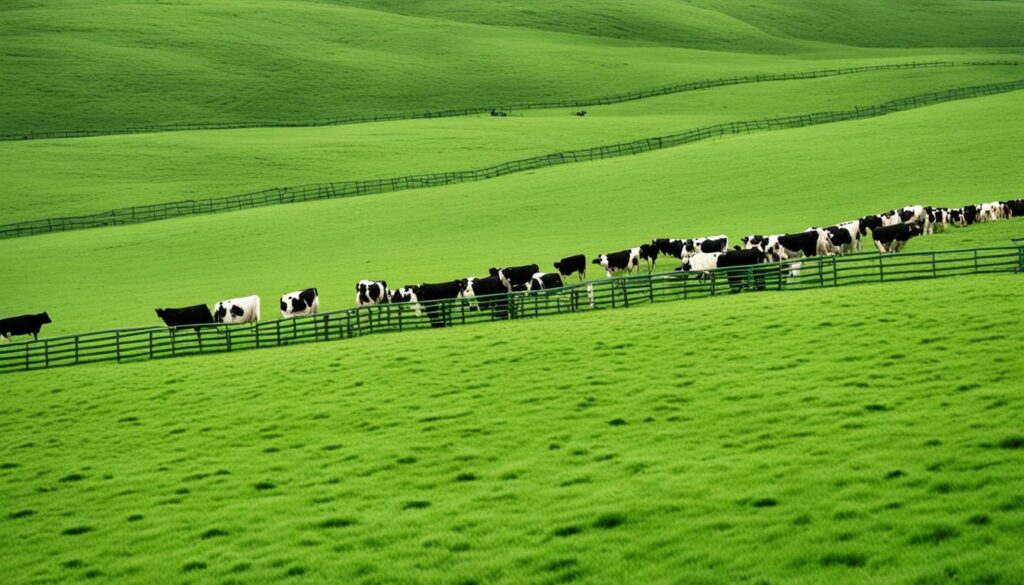
But that’s not all. Rotational grazing can also make a big difference in fighting climate change. It does this by managing animal waste better and improving what they eat. This technique can even reduce the gases that cause climate change by almost 60% in some places, like Blue Mountain Farm in Pennsylvania.
| Benefits of Rotational Grazing | Details |
|---|---|
| Soil Improvement | Enhances soil structure, biodiversity, and organic matter |
| Water Management | Reduces runoff and improves water quality |
| Pasture Resilience | Increases pasture drought resilience and forage availability |
| Cost Reduction | Reduces the need for supplementary feed and increases profits |
| Greenhouse Gas Reduction | Eliminates manure storage and enhances carbon sequestration |
Of course, there are challenges to using rotational grazing. It needs more fences and work. Paddocks must have water and shade. And the ground should not get too hard from too many animals moving around.
To make this work well, get expert advice. A plan made just for your farm is best. This can mean using hay or watching the animals carefully. It’s about giving the land a break at the right times. Using special fences or walkways can stop the ground from getting damaged.
Rotational grazing is key to good land management. It helps the earth and the farm. By using this method, we fight climate change and help farms stay strong. This is good for nature and for those who work the land.
Agroforestry combines farming with tree planting to create diverse, climate-friendly landscapes. These systems are vital for capturing carbon dioxide, as shown by USDA studies. Incorporating forests and trees into agriculture is key to fighting climate change.
Agroforestry brings three main benefits to fighting climate change. It stores carbon in trees and soil, cuts greenhouse gases, and reduces fossil fuel use on farms. Systems like silvopasture, mixing trees with pastures, show great potential. They help the environment, boost farm production, and conserve land.
When even a few farms start agroforestry, it makes a big impact on carbon storage. But, success depends on how these systems are planned and managed. In the Northeast and across the US, there are great chances for farmers to make a difference. Data supports that mixing crops like phalsa with beans and potatoes is both productive and helps store carbon. These findings underline the benefits of investing in agroforestry for the economy and the environment.
To cut down on greenhouse gases, adopt climate-friendly farming techniques. This includes crop rotations and reducing soil disturbance. Also, using renewable energy is important.
Farming activities, like managing soil and livestock, create greenhouse gases. The use of rice, fertilisers, and pesticides also contributes to this footprint.
Sustainable farming helps reduce the carbon footprint and protect the environment for the future. It ensures we have enough food in the long run. It’s good for nature and people.
Crop rotation improves soil by mixing up plants. This helps fight off pests and diseases. It also makes the soil better for growing crops.
The 4Rs mean using the right fertiliser in the right way. It makes farming more efficient and cuts down on pollution. This is key to farming in a sustainable way.
Leaving fields empty can harm the soil and waste fuel. Instead, planting cover crops can keep the land healthy and fight climate change.
Digging less helps cut down on pollution from machinery and keeps the soil healthy. This supports farming that’s better for the environment.
Using cover crops makes the soil richer and stops it from blowing or washing away. They also help the farm be more green and sustainable.
By managing manure well, we can lower harmful gases and keep nutrients in the soil. This makes farming less polluting.
Choosing solar or wind power makes farms cleaner and cheaper to run. These green technologies are good for the farm and the planet.
High-tech fertilisers help crops grow better and don’t harm the environment as much. This means we can farm smarter and greener.
Using data makes farming more efficient and less wasteful. It helps farmers make better choices and protect the environment.
Moving animals from field to field improves the land, stores carbon, and helps manage animals sustainably. It’s good for the planet and the farm.
Agroforestry mixes agriculture and planting trees to store carbon and support wildlife. It makes crops stronger and farming more sustainable.